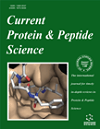- Home
- A-Z Publications
- Current Protein and Peptide Science
- Previous Issues
- Volume 25, Issue 9, 2024
Current Protein and Peptide Science - Volume 25, Issue 9, 2024
Volume 25, Issue 9, 2024
-
-
Recent Developments of Hybrid Fluorescence Techniques: Advances in Amyloid Detection Methods
More LessAuthors: Miraclin P. A. and Priyankar SenAmyloid fibrils are formed from various pathological proteins. Monitoring their aggregation process is necessary for early detection and treatment. Among the available detection techniques, fluorescence is simple, intuitive, and convenient due to its sensitive and selective mode of detection. It has certain disadvantages like poor photothermal stability and detection state limitation. Research has focused on minimising the limitati Read More
-
-
-
A Comprehensive Review on the Significance of Cysteine in Various Metabolic Disorders; Particularly CVD, Diabetes, Renal Dysfunction, and Ischemic Stroke
More LessMetabolic disorders have long been a challenge for medical professionals and are a leading cause of mortality in adults. Diabetes, cardiovascular disorders (CVD), renal dysfunction, and ischemic stroke are the most prevalent ailments contributing to a high mortality rate worldwide. Reactive oxygen species are one of the leading factors that act as a fundamental root cause of metabolic syndrome. All of these disorders have t Read More
-
-
-
s An Overview of the Deubiquitinase USP53: A Promising Diagnostic Marker and Therapeutic Target
More LessAuthors: Guangce Xia, Yulin Guo, Jiajia Zhang, Meng Han, Xiangchao Meng and Ji LvUbiquitination and deubiquitination are important mechanisms to maintain normal physiological activities, and their disorders or imbalances can lead to various diseases. As a subgroup of deubiquitinases (DUBs), the ubiquitin-specific peptidase (USP) family is closely related to many biological processes. USP53, one of the family members, is widely expressed in human tissues and participates in a variety of life activities, such a Read More
-
-
-
Emicizumab as a Promising Form of Therapy for Type A Hemophilia - A Review of Current Knowledge from Clinical Trials
More LessHemophilia is a plasma bleeding disorder characterized by a deficiency of certain blood clotting factors. The most common forms of this disease, i.e., type A and type B, affect approximately 400,000 people worldwide. Without appropriate treatment ensuring the proper coagulation cascade, this disease may lead to serious disability. Minimizing patient discomfort is possible via replacement therapy, consisting of the substitutio Read More
-
-
-
Revolutionizing Infertility Management through Novel Peptide-based Targets
More LessAuthors: Vijay Kumar and Gaurav DoshiAround 48 million couples and 186 million people worldwide have infertility; of these, approximately 85% have an identifiable cause, the most common being ovulatory dysfunctions, male infertility, polycystic ovary syndrome, and tubule disease. The remaining 15% have infertility for unknown reasons, including lifestyle and environmental factors. The regulation of the hypothalamic- pituitary-adrenal axis (HPA) is cruci Read More
-
Volumes & issues
-
Volume 26 (2025)
-
Volume 25 (2024)
-
Volume 24 (2023)
-
Volume 23 (2022)
-
Volume 22 (2021)
-
Volume 21 (2020)
-
Volume 20 (2019)
-
Volume 19 (2018)
-
Volume 18 (2017)
-
Volume 17 (2016)
-
Volume 16 (2015)
-
Volume 15 (2014)
-
Volume 14 (2013)
-
Volume 13 (2012)
-
Volume 12 (2011)
-
Volume 11 (2010)
-
Volume 10 (2009)
-
Volume 9 (2008)
-
Volume 8 (2007)
-
Volume 7 (2006)
-
Volume 6 (2005)
-
Volume 5 (2004)
-
Volume 4 (2003)
-
Volume 3 (2002)
-
Volume 2 (2001)
-
Volume 1 (2000)
Most Read This Month
Article
content/journals/cpps
Journal
10
5
false
en


